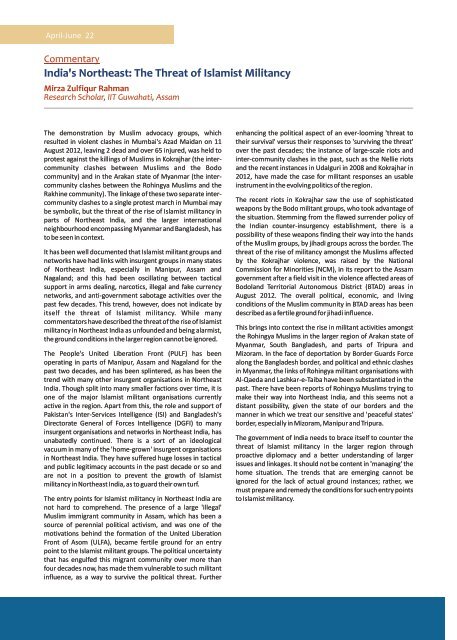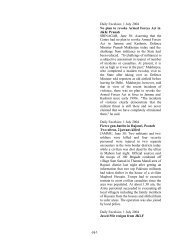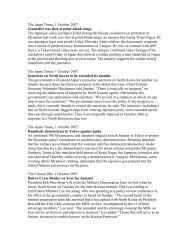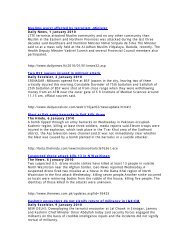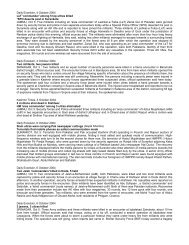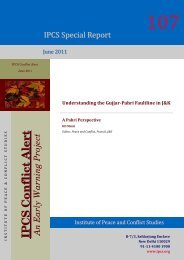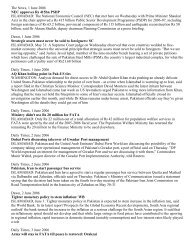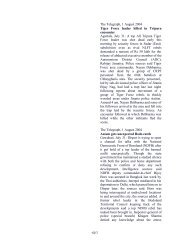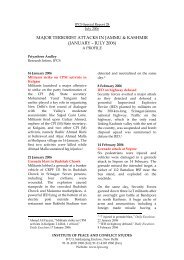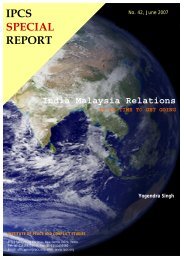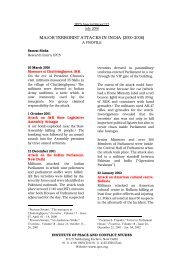April-June 2013 - Institute of Peace and Conflict Studies
April-June 2013 - Institute of Peace and Conflict Studies
April-June 2013 - Institute of Peace and Conflict Studies
You also want an ePaper? Increase the reach of your titles
YUMPU automatically turns print PDFs into web optimized ePapers that Google loves.
<strong>April</strong>-<strong>June</strong> 22<br />
Commentary<br />
India's Northeast: The Threat <strong>of</strong> Islamist Militancy<br />
Mirza Zulfiqur Rahman<br />
Research Scholar, IIT Guwahati, Assam<br />
The demonstration by Muslim advocacy groups, which<br />
resulted in violent clashes in Mumbai's Azad Maidan on 11<br />
August 2012, leaving 2 dead <strong>and</strong> over 65 injured, was held to<br />
protest against the killings <strong>of</strong> Muslims in Kokrajhar (the intercommunity<br />
clashes between Muslims <strong>and</strong> the Bodo<br />
community) <strong>and</strong> in the Arakan state <strong>of</strong> Myanmar (the intercommunity<br />
clashes between the Rohingya Muslims <strong>and</strong> the<br />
Rakhine community). The linkage <strong>of</strong> these two separate intercommunity<br />
clashes to a single protest march in Mumbai may<br />
be symbolic, but the threat <strong>of</strong> the rise <strong>of</strong> Islamist militancy in<br />
parts <strong>of</strong> Northeast India, <strong>and</strong> the larger international<br />
neighbourhood encompassing Myanmar <strong>and</strong> Bangladesh, has<br />
to be seen in context.<br />
It has been well documented that Islamist militant groups <strong>and</strong><br />
networks have had links with insurgent groups in many states<br />
<strong>of</strong> Northeast India, especially in Manipur, Assam <strong>and</strong><br />
Nagal<strong>and</strong>; <strong>and</strong> this had been oscillating between tactical<br />
support in arms dealing, narcotics, illegal <strong>and</strong> fake currency<br />
networks, <strong>and</strong> anti-government sabotage activities over the<br />
past few decades. This trend, however, does not indicate by<br />
itself the threat <strong>of</strong> Islamist militancy. While many<br />
commentators have described the threat <strong>of</strong> the rise <strong>of</strong> Islamist<br />
militancy in Northeast India as unfounded <strong>and</strong> being alarmist,<br />
the ground conditions in the larger region cannot be ignored.<br />
The People's United Liberation Front (PULF) has been<br />
operating in parts <strong>of</strong> Manipur, Assam <strong>and</strong> Nagal<strong>and</strong> for the<br />
past two decades, <strong>and</strong> has been splintered, as has been the<br />
trend with many other insurgent organisations in Northeast<br />
India. Though split into many smaller factions over time, it is<br />
one <strong>of</strong> the major Islamist militant organisations currently<br />
active in the region. Apart from this, the role <strong>and</strong> support <strong>of</strong><br />
Pakistan's Inter-Services Intelligence (ISI) <strong>and</strong> Bangladesh's<br />
Directorate General <strong>of</strong> Forces Intelligence (DGFI) to many<br />
insurgent organisations <strong>and</strong> networks in Northeast India, has<br />
unabatedly continued. There is a sort <strong>of</strong> an ideological<br />
vacuum in many <strong>of</strong> the 'home-grown' insurgent organisations<br />
in Northeast India. They have suffered huge losses in tactical<br />
<strong>and</strong> public legitimacy accounts in the past decade or so <strong>and</strong><br />
are not in a position to prevent the growth <strong>of</strong> Islamist<br />
militancy in Northeast India, as to guard their own turf.<br />
The entry points for Islamist militancy in Northeast India are<br />
not hard to comprehend. The presence <strong>of</strong> a large 'illegal'<br />
Muslim immigrant community in Assam, which has been a<br />
source <strong>of</strong> perennial political activism, <strong>and</strong> was one <strong>of</strong> the<br />
motivations behind the formation <strong>of</strong> the United Liberation<br />
Front <strong>of</strong> Asom (ULFA), became fertile ground for an entry<br />
point to the Islamist militant groups. The political uncertainty<br />
that has engulfed this migrant community over more than<br />
four decades now, has made them vulnerable to such militant<br />
influence, as a way to survive the political threat. Further<br />
enhancing the political aspect <strong>of</strong> an ever-looming 'threat to<br />
their survival' versus their responses to 'surviving the threat'<br />
over the past decades; the instance <strong>of</strong> large-scale riots <strong>and</strong><br />
inter-community clashes in the past, such as the Nellie riots<br />
<strong>and</strong> the recent instances in Udalguri in 2008 <strong>and</strong> Kokrajhar in<br />
2012, have made the case for militant responses an usable<br />
instrument in the evolving politics <strong>of</strong> the region.<br />
The recent riots in Kokrajhar saw the use <strong>of</strong> sophisticated<br />
weapons by the Bodo militant groups, who took advantage <strong>of</strong><br />
the situation. Stemming from the flawed surrender policy <strong>of</strong><br />
the Indian counter-insurgency establishment, there is a<br />
possibility <strong>of</strong> these weapons finding their way into the h<strong>and</strong>s<br />
<strong>of</strong> the Muslim groups, by jihadi groups across the border. The<br />
threat <strong>of</strong> the rise <strong>of</strong> militancy amongst the Muslims affected<br />
by the Kokrajhar violence, was raised by the National<br />
Commission for Minorities (NCM), in its report to the Assam<br />
government after a field visit in the violence affected areas <strong>of</strong><br />
Bodol<strong>and</strong> Territorial Autonomous District (BTAD) areas in<br />
August 2012. The overall political, economic, <strong>and</strong> living<br />
conditions <strong>of</strong> the Muslim community in BTAD areas has been<br />
described as a fertile ground for jihadi influence.<br />
This brings into context the rise in militant activities amongst<br />
the Rohingya Muslims in the larger region <strong>of</strong> Arakan state <strong>of</strong><br />
Myanmar, South Bangladesh, <strong>and</strong> parts <strong>of</strong> Tripura <strong>and</strong><br />
Mizoram. In the face <strong>of</strong> deportation by Border Guards Force<br />
along the Bangladesh border, <strong>and</strong> political <strong>and</strong> ethnic clashes<br />
in Myanmar, the links <strong>of</strong> Rohingya militant organisations with<br />
Al-Qaeda <strong>and</strong> Lashkar-e-Taiba have been substantiated in the<br />
past. There have been reports <strong>of</strong> Rohingya Muslims trying to<br />
make their way into Northeast India, <strong>and</strong> this seems not a<br />
distant possibility, given the state <strong>of</strong> our borders <strong>and</strong> the<br />
manner in which we treat our sensitive <strong>and</strong> 'peaceful states'<br />
border, especially in Mizoram, Manipur <strong>and</strong> Tripura.<br />
The government <strong>of</strong> India needs to brace itself to counter the<br />
threat <strong>of</strong> Islamist militancy in the larger region through<br />
proactive diplomacy <strong>and</strong> a better underst<strong>and</strong>ing <strong>of</strong> larger<br />
issues <strong>and</strong> linkages. It should not be content in 'managing' the<br />
home situation. The trends that are emerging cannot be<br />
ignored for the lack <strong>of</strong> actual ground instances; rather, we<br />
must prepare <strong>and</strong> remedy the conditions for such entry points<br />
to Islamist militancy.


